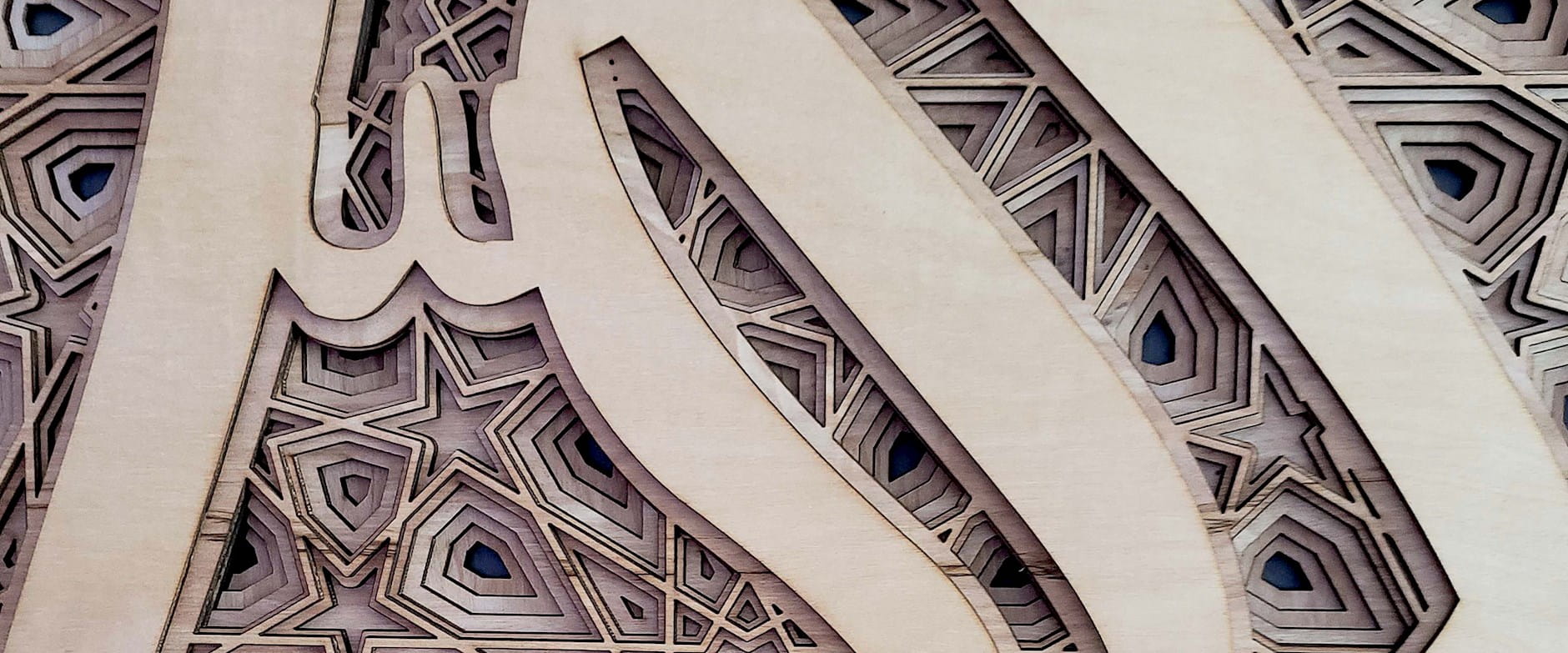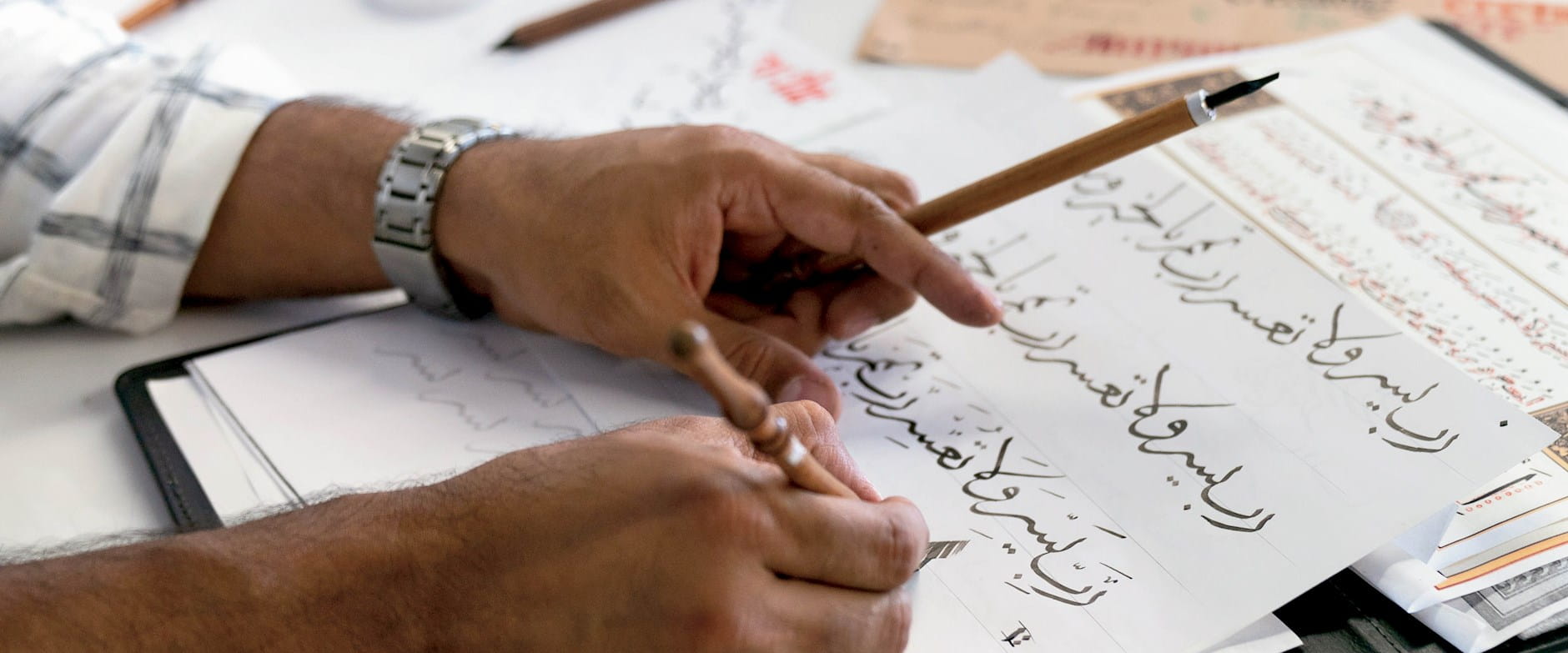In a time of devices and digital apps, Zeeshan Farooq, ’13, favors handwriting.
On coffee mugs with vibrant red or pink interiors, his lively, modern calligraphic script forms the Arabic word Bismillah. Shortened from Bismillah-ir-Rahman-ir-Rahim, it means “In the name of Allah, the most merciful and compassionate.” A metal placard for mirrors reads, in his carefully crafted script: “Oh Allah, just as you made my body beautiful, make my character beautiful as well.”
“I want to play a little part in spreading the beauty of the Arabic script and the religion of Islam,” says Farooq. “That keeps me motivated.”
First captivated by calligraphy’s human details as an elementary-school student in 1980s Pakistan, young Farooq took inspiration from billboard messages in Nastaliq script—a preferred form of calligraphy used for Urdu, the native language of Pakistan. He started his journey by modifying over-the-counter fountain pens to use them for calligraphy. Urdu and Arabic scripts share a common set of alphabets, and he naturally transitioned toward different styles. Handwriting and calligraphy were important skills, particularly pre-internet, and that helped form his own passion for penmanship. Now, as senior product manager of digital innovations at Deerfield, Illinois-based Walgreens Boots Alliance and a former software engineer, Farooq runs a thriving side business, CreationZ Art, designing customized laser-cut Arabic and English calligraphy artwork for clients.
“Booth created that entrepreneurial spirit,” says Farooq. His art business has allowed him to express his creativity outside his primary job—it also helped pay for his 2009 wedding.
1 of 1
He works with clients to learn what they want in their home, then delivers that work with style and flair. He says this element of custom artwork design makes him a “product artist” at his day job, where he listens to customers talk about pain points and creates digital solutions to solve their problems. Farooq hosted his first art booth at an Islamic festival in Chicago in 2011. At the time, his calligraphy veered toward pinks, purples, greens, and yellows. It was different from the silvers and blacks, or golds and blacks, of many Arabic and Islamic art products, and so attracted attention from young Muslims who appreciated the more vibrant themes.
He also likes to reach audiences who aren’t Muslim themselves but appreciate the beauty of his work. His first art commission was from a non-Muslim coworker who wanted Arabic script displayed at home and asked Farooq to choose the topic. He picked “Read, in the name of your Lord, who created,” quoting the introduction of the Qur’an. Essentially, it says to “seek education and depth before taking a path,” adds Farooq.
In another instance, he was invited in 2019 to create a piece for the 2019–21 show American Medina: Stories of Muslim Chicago at the Chicago History Museum.
“I was jumping up and down with the opportunity. I was pretty excited,” says Farooq, whose finished piece involved seven stacked pieces of wood and intricate writing. The message read: “Thanks to Allah.”
“We all understand this concept of being grateful for your health, the weather, for something,” he says on the theme he chose. “We all believe something in common.”
His art also brings him in contact with fellow handwriting enthusiasts. He’s a member of the Chicago Calligraphy Collective, and has shown his work in two of the collective’s annual, juried exhibitions. “When you meet like-minded people, you continue learning from them,” he says. “That helps keep my passion fresh.”
In his effort to promote handwriting, Farooq visits schools and mosques in Chicago, reaching out to kids who may no longer learn script writing in their classes and “are moving away from paper and pen.” And with his three young children, Farooq makes an effort to write an Arabic letter each day in calligraphic script. “I’m trying to make sure this art form survives in a time of devices.”
Through his own work and effort to keep the art alive, Farooq joins a rich history. “A lot of creative ideas have been produced over centuries,” says Farooq. “I’m just a little piece of it.”







